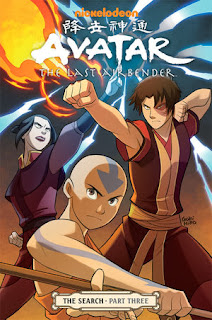Writer: Gene Luen Yang, Michael Dante DiMartino, Bryan Konietzko
Artist: Gurihiru
Letterer: Michael Heisler
Avatar: The Last Airbender created by Michael Dante DiMartino and Bryan Konietzko
In my review of The Search Part One I mentioned how Mike DiMartino and Bryan Konietzko were so effective in drumming up interest in the fate of Zuko’s mother Ursa. Now that they’ve supplied a definitive answer to one of Avatar fandom’s most nagging questions, I’m less sure I needed an answer to begin with. Ursa was not a major onscreen presence within the actual series, and The Search confirms that the reason for her absence is because she chose for it to be that way.
What made such a minor character so interesting has a lot to do with the way women are portrayed within Avatar The Last Airbender. While ATLA is rightfully loved by fans for its youthful, proactive, female characters, the same can’t be said of their adult counterparts. Most of them are either absentee or passive mother figures lacking any real agency. The few who stand out are unattached and/or are villains (Hama). By contrast, the adult men are actively engaged father figures within the series, whether for good (Chief Hakoda, Iroh), bad (Fire Lord Ozai), or somewhere in between (The Mechanist).* This lopsided family dynamic seems to be temporarily subverted in the one episode were Ursa appears in flashback sequences. It’s not just her sudden disappearance that’s intriguing but the character herself. What kind of person would marry a young prince Ozai, raise two kids with him, and go so far as to help her husband usurp the throne? There was an element of moral ambiguity, personal complexity and perhaps even cunning and worldly ambition suggested by her brief appearance quite unlike that of the other women in the series.
The actual Ursa in The Search doesn't quite measure up because her backstory recycles so many soap opera tropes that she morphs into a tragic cypher: Star-crossed lovers, forced into a loveless arranged marriage, the long-suffering wife and mother. It’s fairly retrograde and the creative team of Gene Luen Yang and Gurihiru studios mostly sticks to coloring between the lines. When the plot twist at the end of Part One is predictably revealed to be a red herring initiated by Ursa to fluster Ozai, it completely backfires and heaps more abuse on an innocent Zuko. This quickly crushes her one anaemic act of defiance and provides another unnecessary excuse for Ozai to mistreat his son. Ursa's difficult decision to aid Ozai and leave her children behind is meant to evoke sympathy, but the divine intervention that magically removes her from the narrative also keeps her from having to live with the consequences of her actions. So the twist also comes across as a contrived way to preserve the ATLA status quo.
Another recurring ATLA motif that plays a role in The Search is sibling relationships. This is seen in the affection demonstrated between Katara and Sokka contrasted with the fratricidal actions Azula directs toward Zuko. The book gets rather heavy-handed when it introduces a pair composed of an elderly woman who has spent most of her life searching for a way to reverse a debilitating curse affecting her older brother, the duo’s other member. That's one more self-sacrificing female archetype, just in in case Ursa alone wasn't enough. Such familial devotion is a given for Katara and Sokka while the lesson goes over the head of Azula, who proceeds to betray the pair at the first opportunity. Unlike Zuko, Azula was a unique character in ATLA for being unrepentantly evil, though her emotional isolation turns her into a lower-level Lady Macbeth towards the end. Azula then suffers from some villain decay in The Search. Her behaviour has turned so incredibly erratic (Gurihiru’s portrayal makes her suitably madcap) that she’s treated more as a nuisance than as a credible threat by the cast. Zuko has become so competent in neutralising Azula's deadliest weapon, her lightning bending, that the fight scenes between them, which should be the coolest part of the comic, have dropped off in intensity. That’s a bit unfortunate given that The Search reveals enough of Azula's background to show that she’s as much a victim of Ozai’s upbringing as Zuko was. Probably more in some ways given her position as favored child. The book doesn’t quite make that connection, missing out on turning Azula into a more nuanced character, though it does manage to bring out the cray-zee.
While I’ve dinged The Search for some of its storytelling choices and its old-fashioned gender roles, those choices do fit into the carefully constructed box designed by Bryan and Mike. Ursa may not be as potent a force as I've hoped for, but she is still one of a few flawed figures who have made morally dubious decisions that place her in a gray area between good and evil. And if the plan is for Azula to get a better handle on her fragile mental state, this could reposition her to claim the label of conflicted teenager formerly monopolised by Zuko. Comparing The Search to their work in The Promise, Gene and Gurihiru have become more efficient manipulating the numerous moving parts of the ATLA universe. This arc comes closer to duplicating an episode of the series, and this makes for a more manageable narrative. The cast is now limited to a few important characters, and the plot focuses on one problem at a time. Even its unresolved ending is structured to be a jumping-off point for future entries. Now that Ursa and Azula are both re-entering the game, the comic version of ATLA has become a tad less settled.
___
* This pattern still persists in The Legend of Korra despite this series being set seventy years after the events in ATLA.




